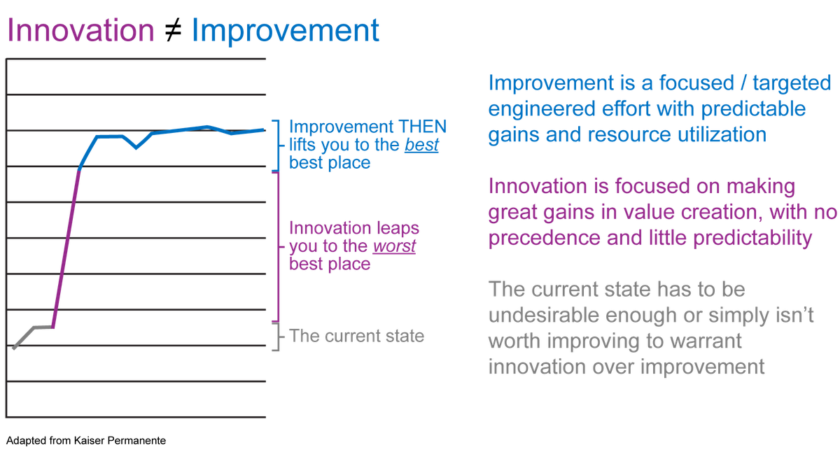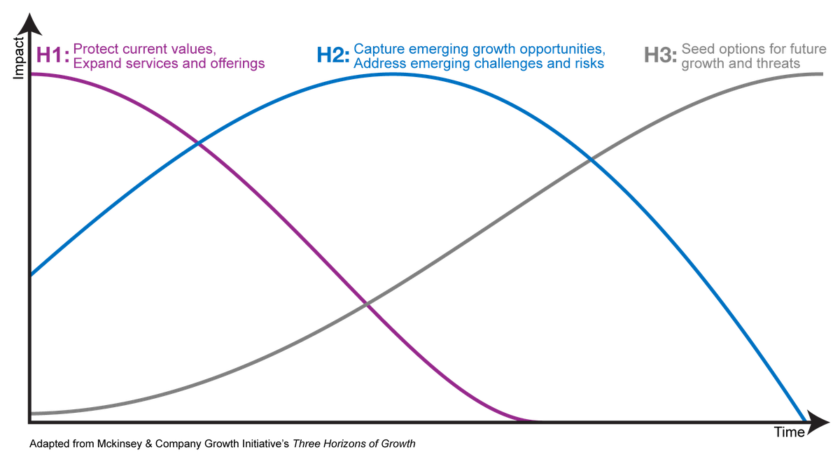"Continuous improvement isn’t nearly as important as discontinuous improvement. Creativity is a discontinuity. A creative act breaks with the chain that has come before it."
Since 2005, MaRS Discovery District has had the privilege of working with some of the most inspiring innovators in Canada and abroad. Many of our innovation partners work in the Government of Canada, and the governments of the Canadian provinces, territories and municipalities.
From our experience, one thing stands out: improvement is not innovation. If your organisation uses these terms interchangeably, or has an innovation strategy that manages both innovation and improvement in the same way, it will very likely fail to achieve anything truly innovative.
MaRS Discovery District defines innovation as the invention of a new way of creating significantly more value and the adoption of this invention at scale.
This definition contains three key ideas.
1. New way
If it is not new, if someone else somewhere else in the world has already invented it and made it work, it is not innovation. Call it improvement, or call it the adoption of a good idea. If the invention itself is not new, but the policy or the business model is, then be precise and qualify where innovation is happening. Call it policy innovation or business model innovation respectively.²
2. Significantly more value
Innovation is not a 10% gain in efficiency or effectiveness (1.1x). Innovation should aim for 10x gains in value creation. Why? Because 10x forces you to re-examine fundamental assumptions, diverge from business as usual, forge unlikely partnerships, and experiment with new technologies, business models, and organisational forms.
You won’t always achieve 10x. Maybe you only make 2x. But that’s still 90% more than if you aimed for 1.1x. Plus, you’ll learn faster and differently. Which means: innovation is high uncertainty, high return work. And there are no shortcuts to high returns. You can’t innovate off the side of your desk. It’s not going to happen in an ivory tower or a shiny lab disconnected from core government business.
When you have a bold goal, you need the fuel, air cover and runway to match. Innovation projects should start out lean and agile, but the successful ones will grow into major transformation initiatives that enhance government’s legitimacy, effectiveness and efficiency. The unsuccessful ones should be terminated – and their learnings harvested – when they fail to achieve liftoff. This frees up the resources needed for new innovation.
3. Adoption
When invention becomes adopted at scale, it becomes the new normal. This is why we talk about Nikola Tesla as the inventor who was ahead of his times, but Thomas Edison as the innovator. This is also one of the trickiest aspects of innovation. Innovation efforts have to be bold and pushing boundaries, yet at the same time be plausible and timely. The delay between invention and adoption is often measured in decades, for two reasons:
- New inventions rarely work optimally at inception. Consider the darling of commercial innovation, Apple. The iPod was a niche product at launch. But over time, through iteration and pivots in the technology, business model, user experience and marketing, it became a category leader, and paved the way for the iPhone.
- A new idea is usually rejected or resisted by the prevailing system in proportion to its novelty. Adoption of a truly disruptive idea requires systems change: coordinated shifts in resource flows, policies and regulations, social values and infrastructure. For example, disruptive innovations like Napster, Bitcoin and Airbnb had to first operate outside the law or in regulatory grey zones before laws and social norms could adjust and adapt.
Defining what innovation actually is
Compare the MaRS definition of innovation above with two common public sector descriptions:
"There is no one single definition. But innovation as described in the Innovation Union plan broadly means change that speeds up and improves the way we conceive, develop, produce and access new products, industrial processes and services. Changes that create more jobs, improve people's lives and build greener and better societies."
And:
"At its most basic, innovation is about making things better in ways that benefit everyone. Innovation isn't always based on technology. Any idea can be transformed into a simple solution that results in new products or services. Innovations can create entirely new jobs, markets and industries that never existed before. And they can give existing industries a new lease on life by making them more productive and efficient."
The problem: they don’t say what innovation is not; and they are not a useful guide for action.
We often hear senior leaders say they do not want to define innovation too clearly so there is room for flexibility and interpretation. Yet this is the number one complaint we hear from civil servants. There is no clarity on what innovation is, how to know which projects are innovative, and how to prioritise innovation when and where it is needed most.
In contrast, the Built in Canada Innovation Program gets it:
"An invention, new technology or new process that is not currently available in the marketplace. An improvement to an existing technology/process that represents a significant (generally patentable) improvement in functionality, cost or performance of goods and services that are considered state of the art or the current industry best practice. Incremental improvements, 'good engineering' and technologies that would go ahead in a normal course of product development (i.e. the next version or release) are not considered as 'innovations' for the purposes of this program."
And we can guess why: accountability and goal clarity. In this case, decision makers are clear enough about their innovation objectives to approve a mandate with significant funding and have to be sure the programme generates significant value.
A difference that makes a difference
When we differentiate innovation from improvement, it enables government to:
- Set an innovation agenda that is bold, clear, actionable and highly differentiated from the status quo. The Government of Dubai and the Mohammed Bin Rashid Centre for Government Innovation sets a useful example.
- Create a portfolio that balances innovation and improvement. Resource investments can be intentionally allocated using a portfolio management framework, such as McKinsey’s three horizons, shown in Figure 2 below. MaRS Solutions Lab worked with ESDC Innovation LAB in 2018 to perform an innovation scan of ESDC. The report presented a portfolio approach that differentiated between – and balanced – innovation and improvement. Most governments invest in many more improvements than innovations, and this is usually appropriate.
- Manage innovation projects differently than improvement projects, especially with respect to priority setting, resource management and risk management. Innovation is resource intensive and has high uncertainty, requiring comparatively more investment in divergent and exploratory activities, such as early concept prototyping. Improvement initiatives require predictable resources and yield smaller but more predictable gains that tend to diminish over time.
- Attract innovation talent and build innovation teams. Nesta’s public sector innovation competency framework suggests that innovation teams require leaders, learners and collaborators. Doblin’s ten types of innovation suggests that designers/researchers, engineers and business developers form the core of an innovation team. Sergio Marrero coined these four roles; the hipster, hound, hacker and hustler. Whichever framework is used, the innovation team also needs to understand both government and the specific problem domain. Innovation requires content as well as process expertise.
Conclusion
We have defined innovation as the invention of a new way of creating significantly more value and the adoption of the invention at scale.
This definition is useful because it differentiates innovation from improvement. It informs government how to set an innovation agenda, create and manage a portfolio of innovations and improvements, and build well-rounded teams to implement on the agenda.
Improvement and innovation are highly complementary dual processes. When they are confused in the public service, both suffer, and genuine innovation stalls.
Footnotes
¹ Russ Ackoff: What’s a system?
² By policy, we mean a deliberate system of principles to guide government decisions and achieve rational outcomes. Policy innovation includes innovation in both the what (the policy instrument or artifact) and the how (policy development processes and tools) of policy. By business model, we mean the rationale of how an organisation creates, delivers, and captures value. Business model innovation includes the invention and adoption of new value propositions, new funding and cost structures, new ways of delivering value to citizens and working with partners.



